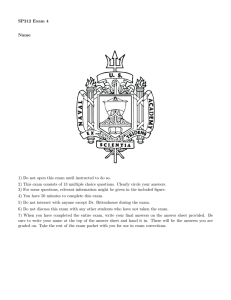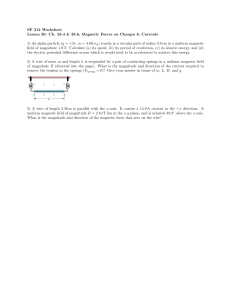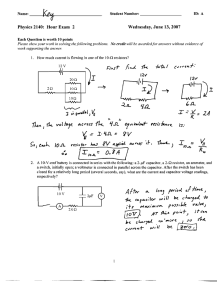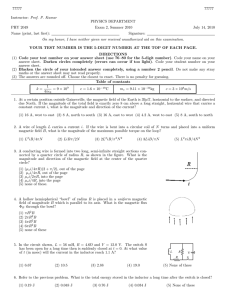Practice - Department of Physics
advertisement
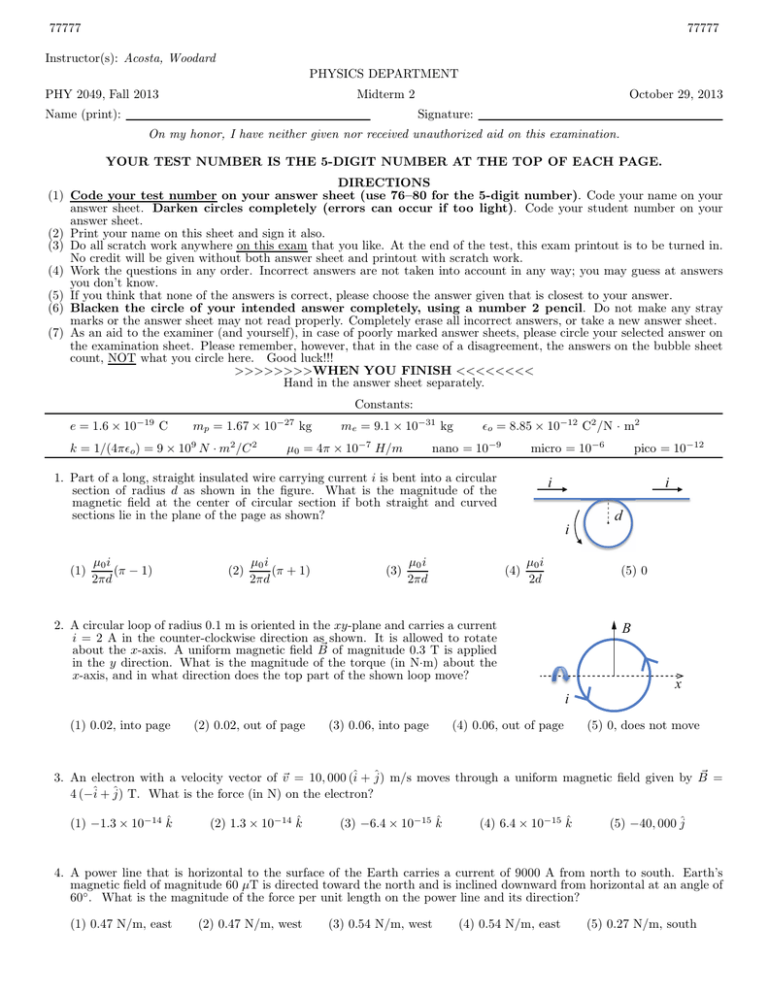
77777 77777 Instructor(s): Acosta, Woodard PHYSICS DEPARTMENT PHY 2049, Fall 2013 Midterm 2 Name (print): October 29, 2013 Signature: On my honor, I have neither given nor received unauthorized aid on this examination. YOUR TEST NUMBER IS THE 5-DIGIT NUMBER AT THE TOP OF EACH PAGE. DIRECTIONS (1) Code your test number on your answer sheet (use 76–80 for the 5-digit number). Code your name on your answer sheet. Darken circles completely (errors can occur if too light). Code your student number on your answer sheet. (2) Print your name on this sheet and sign it also. (3) Do all scratch work anywhere on this exam that you like. At the end of the test, this exam printout is to be turned in. No credit will be given without both answer sheet and printout with scratch work. (4) Work the questions in any order. Incorrect answers are not taken into account in any way; you may guess at answers you don’t know. (5) If you think that none of the answers is correct, please choose the answer given that is closest to your answer. (6) Blacken the circle of your intended answer completely, using a number 2 pencil. Do not make any stray marks or the answer sheet may not read properly. Completely erase all incorrect answers, or take a new answer sheet. (7) As an aid to the examiner (and yourself), in case of poorly marked answer sheets, please circle your selected answer on the examination sheet. Please remember, however, that in the case of a disagreement, the answers on the bubble sheet count, NOT what you circle here. Good luck!!! >>>>>>>>WHEN YOU FINISH <<<<<<<< Hand in the answer sheet separately. Constants: e = 1.6 × 10 −19 C mp = 1.67 × 10 k = 1/(4πǫo) = 9 × 109 N · m2 /C 2 −27 kg me = 9.1 × 10−31 kg µ0 = 4π × 10−7 H/m ǫo = 8.85 × 10−12 C2 /N · m2 nano = 10−9 micro = 10−6 1. Part of a long, straight insulated wire carrying current i is bent into a circular section of radius d as shown in the figure. What is the magnitude of the magnetic field at the center of circular section if both straight and curved sections lie in the plane of the page as shown? pico = 10−12 i i d i (1) µ0 i (π − 1) 2πd (2) µ0 i (π + 1) 2πd (3) µ0 i 2πd (4) µ0 i 2d (5) 0 2. A circular loop of radius 0.1 m is oriented in the xy-plane and carries a current i = 2 A in the counter-clockwise direction as shown. It is allowed to rotate ~ of magnitude 0.3 T is applied about the x-axis. A uniform magnetic field B in the y direction. What is the magnitude of the torque (in N·m) about the x-axis, and in what direction does the top part of the shown loop move? B x i (1) 0.02, into page (2) 0.02, out of page (3) 0.06, into page (4) 0.06, out of page (5) 0, does not move ~ = 3. An electron with a velocity vector of ~v = 10, 000 (î + ĵ) m/s moves through a uniform magnetic field given by B 4 (−î + ĵ) T. What is the force (in N) on the electron? (1) −1.3 × 10−14 k̂ (2) 1.3 × 10−14 k̂ (3) −6.4 × 10−15 k̂ (4) 6.4 × 10−15 k̂ (5) −40, 000 ĵ 4. A power line that is horizontal to the surface of the Earth carries a current of 9000 A from north to south. Earth’s magnetic field of magnitude 60 µT is directed toward the north and is inclined downward from horizontal at an angle of 60◦ . What is the magnitude of the force per unit length on the power line and its direction? (1) 0.47 N/m, east (2) 0.47 N/m, west (3) 0.54 N/m, west (4) 0.54 N/m, east (5) 0.27 N/m, south 77777 77777 5. In the circuit shown, ε1 = 3.0 V and ε2 = ε3 = 1.5 V. Also R1 = 2 Ω and R2 = R3 = 1 Ω. What is the magnitude of the current flowing through R2 ? (1) (2) (3) (4) (5) 0.3 1.5 0.6 0.9 0 + A A A A − R1 ε1 − (2) 1 R 4 (3) R − ε3 R ε 3 R 5 + ε2 + 6. What is the equivalent resistance of the shown circuit as seen by the EMF source if all resistors have resistance R? (1) R2 R3 R R (4) 4 R (5) R 5 R 2 7. The current density ~j inside a long, solid, cylindrical wire of radius a is in the direction of the central axis, and its magnitude varies inversely with radial distance r from the axis according to j = j0 a/r. Find the magnitude of the magnetic field at r = a/2. (1) µ0 j0 a (2) µ0 j0 a/2 (3) µ0 j0 a/3 (4) µ0 j0 a/4 (5) µ0 j0 a ln(a/2) 8. To create a magnetic field of 2 T inside of a solenoid of length 50 cm and radius 1 cm, how many total windings are required for the entire length if the current in the wire cannot exceed 10 A? (1) 80, 000 (2) 160, 000 (3) 1, 600 (4) 10, 000 (5) 800, 000 9. A proton of velocity 6 × 107 m/s and mass 1.67 × 10−27 kg is to be kept in a circular orbit using a magnet. What is the minimum diameter of the magnet necessary assuming that it provides a uniform magnetic field of 0.5 T between its pole tips. (1) 2.5 m (2) 1.2 m (3) 6.5 × 107 m (4) 1.6 m (5) 0.8 m 10. An initially uncharged capacitor and a 100 kΩ resistor are connected in series with an EMF source at t = 0 to form a complete circuit. If the capacitor is charged to half of its maximum value in 0.1 s, what must be the capacitance of the capacitor? (1) 1.4 µF (2) 1.0 µF (3) 6.9 × 105 F (4) 0.5 µF (5) 0.5 F 11. Consider a circular loop of current as shown in the figure, where the distance r to point P along the axis of the loop is much larger than the loop radius R. If the distance r to point P is doubled, what is the ratio of the magnitude of the magnetic field at the new location of P to that at the original position? P r R (1) 1/8 (2) 8 (3) 1/4 (4) 4 (5) 1/2 i 77777 77777 12. In the figure shown, a metal rod is pulled at a constant velocity along two parallel metal rails, connected with a strip of metal at one end. A magnetic ~ = 0.50 T points out of the page. If the metal rod has field of magnitude B a length L = 0.25 m and a resistance of 0.3 Ω, what is the force necessary (in N) to pull the rod with a velocity of 2 m/s? The rails and connector have negligible resistance. (1) 0.1 (2) 0.25 (3) 0.8 v L B (4) 0.03 (5) 2.0 13. The magnetic field passing perpendicularly through a square conducting loop of side length 2 m as shown decreases linearly from 2 T to 0 in 100 seconds. What is the induced EMF and the direction of the induced current? 0.08 0.08 0.16 0.16 0.02 V, V, V, V, V, B counter-clockwise clockwise counter-clockwise clockwise clockwise 14. The current through an inductor with inductance L = 0.3 H is shown by the graph, with the direction from left to right through the inductor as shown. What is the EMF across the inductor (VL = Vright − Vleft ), including sign, at t = 1 ms? i (A) (1) (2) (3) (4) (5) VL i 9 8 7 6 5 4 3 2 1 0 0 1 2 3 4 5 6 t (ms) (1) 900 V (2) −900 V (3) 1500 V (4) −750 V 15. The switch S in the shown RL circuit is closed at time t = 0. If L = 10 H, R = 2 Ω, and ε = 6 V, what is the magnitude of the potential difference across the inductor immediately after closing the switch. (5) −2 V S ε R L (1) 6 V (2) 0 V (3) 3 V (4) 5 V (5) 30 V 16. Two wires are made of the same material. The second wire has twice the radius and twice the length of the first wire. What is the ratio of the second wire’s resistance to the first one? (1) 1 2 (2) 2 (3) 8 (4) 1 8 (5) 1 17. A 5 Ohm resistor dissipates 10 Watts of power. What is the current i (in amps) through the resistor and the voltage V (in volts) across it? (1) (2) (3) (4) (5) √ √ 2, V = 5√2 i= √ V = 2 i = 5 2, i = 2, V =5 i = 5, V =2 √ √ V = 10 i = 10, 7 77777 77777 18. In the figure, R = 14.0 Ω, C = 6.20 µF, and L = 54.0 mH, and the ideal battery has emf E = 34.0 V. The switch is kept at a for a long time and then thrown to position b. What are the frequency f (not angular frequency!) in Hz and the amplitude of the current oscillation i in Amps? (1) (2) (3) (4) (5) f f f f f = 275, = 1730, = 43.8, = 275, = 1730, R ε C L i = .364 i = .0580 i = 2.29 i = 2.43 i = 2.43 a b 19. An LC circuit with capacitance C = 4 µF and inductance L = 2.5 mH carries a total energy of U = 10 mJ. At a particular instant the current through the inductor is i = 2 A. What is the charge on the capacitor at the same instant? (1) 200 µC (2) 283 µC (3) 400 µC (4) 141 µC (5) 566 µC 20. What resistance R should be connected in series with an inductance L = 220 mH and capacitance C = 12.0 µF for the maximum charge on the capacitor to decay to 99.0% of its initial value in 50.0 cycles? (Assume ω ′ ≈ ω.) (1) 8.66 mΩ (2) 4.33 mΩ (3) 54.5 mΩ (4) 3.76 mΩ (5) 1.88 mΩ
